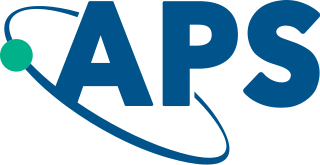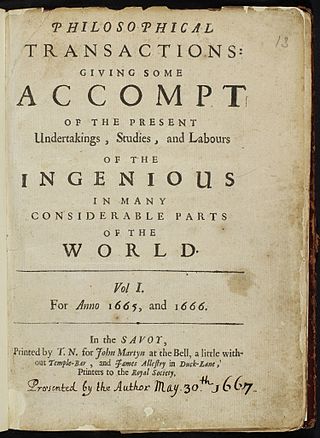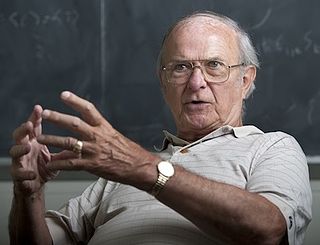Related Research Articles

In academic publishing, a scientific journal is a periodical publication designed to further the progress of science by disseminating new research findings to the scientific community. These journals serve as a platform for researchers, scholars, and scientists to share their latest discoveries, insights, and methodologies across a multitude of scientific disciplines. Unlike professional or trade magazines, scientific journals are characterized by their rigorous peer review process, which aims to ensure the validity, reliability, and quality of the published content. With origins dating back to the 17th century, the publication of scientific journals has evolved significantly, playing a pivotal role in the advancement of scientific knowledge, fostering academic discourse, and facilitating collaboration within the scientific community.

The American Physical Society (APS) is a not-for-profit membership organization of professionals in physics and related disciplines, comprising nearly fifty divisions, sections, and other units. Its mission is the advancement and diffusion of knowledge of physics. It publishes more than a dozen scientific journals, including the prestigious Physical Review and Physical Review Letters, and organizes more than twenty science meetings each year. It is a member society of the American Institute of Physics. Since January 2021, it is led by chief executive officer Jonathan Bagger.

Scientific literature encompasses a vast body of academic papers that spans various disciplines within the natural and social sciences. It primarily consists of academic papers that present original empirical research and theoretical contributions. These papers serve as essential sources of knowledge and are commonly referred to simply as "the literature" within specific research fields.
Physical Review is a peer-reviewed scientific journal established in 1893 by Edward Nichols. It publishes original research as well as scientific and literature reviews on all aspects of physics. It is published by the American Physical Society (APS). The journal is in its third series, and is split in several sub-journals each covering a particular field of physics. It has a sister journal, Physical Review Letters, which publishes shorter articles of broader interest.
Proceedings of the Royal Society is the main research journal of the Royal Society. The journal began in 1831 and was split into two series in 1905:

PLATO is a suite of programs for electronic structure calculations. It receives its name from the choice of basis set used to expand the electronic wavefunctions.
Sir Thomas Walter Bannerman Kibble was a British theoretical physicist, senior research investigator at the Blackett Laboratory and Emeritus Professor of Theoretical Physics at Imperial College London. His research interests were in quantum field theory, especially the interface between high-energy particle physics and cosmology. He is best known as one of the first to describe the Higgs mechanism, and for his research on topological defects. From the 1950s he was concerned about the nuclear arms race and from 1970 took leading roles in promoting the social responsibility of the scientist.

The American Institute of Physics (AIP) promotes science and the profession of physics, publishes physics journals, and produces publications for scientific and engineering societies. The AIP is made up of various member societies. Its corporate headquarters are at the American Center for Physics in College Park, Maryland, but the institute also has offices in Melville, New York, and Beijing.
SPIE is an international not-for-profit professional society for optics and photonics technology, founded in 1955. It organizes technical conferences, trade exhibitions, and continuing education programs for researchers and developers in the light-based fields of physics, including: optics, photonics, and imaging engineering. The society publishes peer-reviewed scientific journals, conference proceedings, monographs, tutorial texts, field guides, and reference volumes in print and online. SPIE is especially well-known for Photonics West, one of the laser and photonics industry's largest combined conferences and tradeshows which is held annually in San Francisco. SPIE also participates as partners in leading educational initiatives, and in 2020, for example, provided more than $5.8 million in support of optics education and outreach programs around the world.

Atmospheric Chemistry and Physics is an open access peer-reviewed scientific journal published by the European Geosciences Union. It covers research on the Earth's atmosphere and the underlying chemical and physical processes, including the altitude range from the land and ocean surface up to the turbopause, including the troposphere, stratosphere, and mesosphere. The main subject areas comprise atmospheric modelling, field measurements, remote sensing, and laboratory studies of gases, aerosols, clouds and precipitation, isotopes, radiation, dynamics, and biosphere and hydrosphere interactions. Article types published are research and review articles, technical notes, and commentaries.

François, Baron Englert is a Belgian theoretical physicist and 2013 Nobel Prize laureate.

Physical Review B: Condensed Matter and Materials Physics is a peer-reviewed, scientific journal, published by the American Physical Society (APS). The Editor of PRB is Stephen E. Nagler. It is part of the Physical Review family of journals. The current Editor in Chief is Randall Kamien. PRB currently publishes over 4500 papers a year, making it one of the largest physics journals in the world.

Carl Richard Hagen is a professor of particle physics at the University of Rochester. He is most noted for his contributions to the Standard Model and Symmetry breaking as well as the 1964 co-discovery of the Higgs mechanism and Higgs boson with Gerald Guralnik and Tom Kibble (GHK). As part of Physical Review Letters 50th anniversary celebration, the journal recognized this discovery as one of the milestone papers in PRL history. While widely considered to have authored the most complete of the early papers on the Higgs theory, GHK were controversially not included in the 2013 Nobel Prize in Physics.
Journal of Physics G: Nuclear and Particle Physics is a peer-reviewed journal that publishes theoretical and experimental research into nuclear physics, particle physics and particle astrophysics, including all interface areas between these fields.
Computational particle physics refers to the methods and computing tools developed in and used by particle physics research. Like computational chemistry or computational biology, it is, for particle physics both a specific branch and an interdisciplinary field relying on computer science, theoretical and experimental particle physics and mathematics. The main fields of computational particle physics are: lattice field theory, automatic calculation of particle interaction or decay and event generators.
Steven H. Simon is an American theoretical physics professor at Oxford University and professorial fellow of Somerville College, Oxford. From 2000 to 2008 he was the director of theoretical physics research at Bell Laboratories. He has served on the UK EPSRC Physical Sciences Strategic Advisory Board. He is known for his work on topological phases of matter, topological quantum computing, and fractional quantum Hall effect. He is a co-author of a highly cited review on these subjects. He has also written many papers in the field of information theory. He is the author of a popular introductory book on solid state physics entitled The Oxford Solid State Basics as well as a more recent book entitled Topological Quantum. He is married to political science professor Janina Dill.
Physical Review A is a monthly peer-reviewed scientific journal published by the American Physical Society covering atomic, molecular, and optical physics and quantum information. As of 2021 the editor was Jan M. Rost.
F. D. C. Willard (1968–1982) was the pen name of Chester, a Siamese cat, used on several papers written by his owner, J. H. Hetherington, in physics journals. On one occasion, he was listed as the sole author.
Physical Review X is a peer-reviewed open access scientific journal published by the American Physical Society covering all branches of pure, applied, and interdisciplinary physics. It is part of the Physical Review family of journals. Since 2022, Ling Miao was appointed full-time chief editor, while Denis Bartolo from École normale supérieure de Lyon is the current lead editor. According to the Journal Citation Reports, the journal had a 2021 impact factor of 14.417.

The Sponsoring Consortium for Open Access Publishing in Particle Physics (or SCOAP3) is an international collaboration in the high-energy physics community to convert traditional closed access physics journals to open access, freely available for everyone to read and reuse, shifting away the burden of the publishing cost from readers (traditional model) and authors (in the case of hybrid open access journals). Under the terms of the agreement, authors retain copyrights and the articles published under SCOAP3 will be in perpetuity under a CC BY license. The initiative was promoted by CERN in collaboration with international partners.